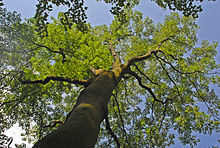Trees of gods
| Trees of gods | ||||||||||||
|---|---|---|---|---|---|---|---|---|---|---|---|---|

Tree of Gods ( Ailanthus altissima ) |
||||||||||||
| Systematics | ||||||||||||
|
||||||||||||
| Scientific name | ||||||||||||
| Ailanthus | ||||||||||||
| Desf. |
The trees of the gods ( Ailanthus ) are a genus of plants in the bitter ash family (Simaroubaceae). The genus Ailanthus is represented with three to ten species in South and East Asia and in northern Australia . The best-known species, also often planted in Central Europe, is the tree of the gods ( Ailanthus altissima ). There are fossil finds from the Tertiary of the northern hemisphere (the minimum age for the genus is given as the Early Eocene ).
description


Vegetative characteristics
Tree of the gods are large to small, deciduous trees . They are very undemanding and grow quickly. The alternate leaves are relatively long and pinnate with 13 to 41 leaflets. The more or less opposite leaflets sometimes have a few large teeth at their base with the mouth of a slightly curved gland. Stipules are missing.
Generative characteristics
Tree of the gods species are dioecious, separate sexes ( diocesan ). Sideways, paniculate inflorescences are formed. There are as many sepals as there are petals. The unisexual or sometimes hermaphrodite flowers are radial symmetry and usually five, rarely six-fold. Male flowers contain ten, hermaphrodite only five to six fertile stamens , but then the rest of the number as staminodes . There are two to five free, upper, flat carpels with five chambers each, each containing only one ovule . The two to five styles can be free or grown together. The fruits are winged and each form a samara.
Systematics and distribution
Ailanthus was first published in 1786 by René Louiche Desfontaines in Histoire de l'académie royale des sciences. Avec les mémoires de mathématique & de physique (Paris) , p. 265. A synonym for Ailanthus Desf. nom. cons. is Hebonga Radlk.
The roughly ten species spread from Asia to northern Oceania . There are about six species in China, five of which are only found there.
There are around ten Ailanthus species (selection):
-
Tree of the Gods ( Ailanthus altissima (Mill.) Swingle , Syn .: Ailanthus cacodendron (Ehrh.) Schinz & Thell. , Ailanthus glandulosa Desf. , Ailanthus peregrina (Buc'hoz) FABarkley , Rhus cacodendron Ehrh. , Toxicodendron altissimum Mill. ): Sie is common in China and Taiwan and there are the following varieties:
- Ailanthus altissima (Mill.) Swingle var. Altissima : It is distributed in almost all regions of China and is only not found in the Chinese provinces of Hainan, Heilongjiang, Jilin, Ningxia and Qinghai. It is a neophyte in many areas of the world .
- Ailanthus altissima var. Sutchuenensis (Dode) Rehder & EHWilson : It thrives at altitudes of 1700 to 2500 meters in the Chinese provinces of Guangxi , Hubei , Hunan , Jiangxi , Sichuan and Yunnan .
- Ailanthus altissima var. Tanakae (Hayata) Kanehira & Sasaki : It thrives mainly in mountain forests only in northern Taiwan .
- Ailanthus excelsa Roxb. : It occurs in India and Sri Lanka .
- Ailanthus fordii Nooteboom : It thrives in mixed forests on hills and mountains at altitudes of around 600 meters in southern Guangdong and in Xishuangbanna in southern Yunnan.
- Girald's tree of gods ( Ailanthus giraldii Dode ): It thrives in light forests or mixed forests in mountains in the Chinese provinces of Gansu, Shaanxi, Sichuan and Yunnan.
- Ailanthus guangxiensis X.L.Mo ex CFLiang & XLMo : This endemic thrives in forests in the valleys of the tropical Karst at altitudes of around 300 meters only in Longzhou and Ningming in southwestern Guangxi.
- Ailanthus triphysa (Dennstedt) Alston (Syn .: Ailanthus malabarica DC. , Ailanthus imberbiflora F. Muell. ): It is found in India, Sri Lanka, Thailand , Cambodia , Vietnam , China, Malaysia , Indonesia , the Philippines and Australia widespread.
- Thorny tree of the gods ( Ailanthus vilmoriniana Dode ): It thrives in light forests on slopes or valleys in mountains at altitudes of 500 to 2800 meters in the Chinese provinces of Hubei, Sichuan and Yunnan.
Problem
The tree of gods ( Ailanthus altissima ) is one of the so-called garden refugees . It spreads quickly and uncontrollably, displacing native trees. It spread particularly abundantly in Central Europe after the Second World War on the rubble plots. In Italy it is seen as a plague. Despite the smooth bark, it has proven to be mistletoe-proof.
Due to its robustness, the tree of the gods can be found in some cities in green strips between traffic areas, but many parts of the tree of gods are poisonous. Precautions should be taken, especially when removing and pruning, as any contact can lead to allergic reactions.
swell
- Kamal A. Malik: Ailanthus : Online in the Flora of Pakistan . (English)
- Hua Peng, Wm. Wayt Thomas: Simaroubaceae. : Ailanthus , p. 100 - online with the same text as the printed work , In: Wu Zheng-yi, Peter H. Raven, Deyuan Hong (Eds.): Flora of China , Volume 11 - Oxalidaceae through Aceraceae , Science Press and Missouri Botanical Garden Press , Beijing and St. Louis, April 18, 2008, ISBN 978-1-930723-73-3 .
Individual evidence
- ^ A b c Ailanthus in the Germplasm Resources Information Network (GRIN), USDA , ARS , National Genetic Resources Program. National Germplasm Resources Laboratory, Beltsville, Maryland. Retrieved June 15, 2017.
- ↑ a b c d e f g h i Hua Peng, Wm. Wayt Thomas: Simaroubaceae. : Ailanthus , p. 100 - online with the same text as the printed work , In: Wu Zheng-yi, Peter H. Raven, Deyuan Hong (Eds.): Flora of China , Volume 11 - Oxalidaceae through Aceraceae , Science Press and Missouri Botanical Garden Press , Beijing and St. Louis, April 18, 2008, ISBN 978-1-930723-73-3 .
- ↑ Ailanthus garden database

